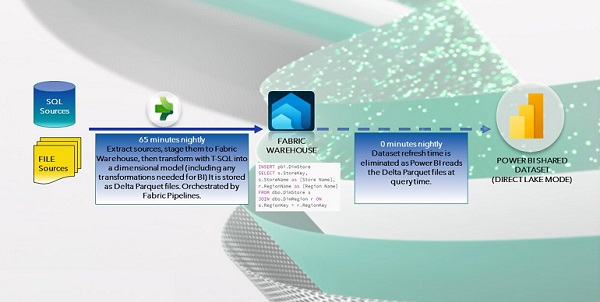Introduction to Microsoft Power BI Direct Lake Mode
Microsoft’s powerful business intelligence tool, Power BI, is always adding new capabilities to improve analytics and data visualization. The Direct Lake mode, a new approach in data communication that combines the finest elements of the Import and Direct Query modes, is one of its extraordinary features. This blog post goes further into Power BI Direct Lake mode, examining its features, benefits, applications, and best practices for deployment.
You will have a comprehensive knowledge of how Direct Lake mode can improve your data analytics processes by the end of this guide. Maximize the benefits of Power BI Direct Lake Mode with personalized Power BI consulting services that guide you with setup and best practices.
READ – How to Fast with Power BI Key Influencers Root Cause Analysis
Direct Lake Mode: What is it?
Without the need for data import or on-demand queries, Direct Lake mode is a data connectivity option that allows users to access data straight from Azure Data Lake Storage (ADLS) Gen2 or other compatible data lake platforms. Direct Lake Mode combines high-performance in-memory analytics with the flexibility of live connections to data in the lake, in contrast to the conventional Import mode, which loads data into Power BI in-memory engine, or Direct Query mode, which gets data from the source as needed.

For modern analytics scenarios, Power BI Direct Lake mode is especially helpful because it enables expands to:
- Examine enormous volumes of data that are kept in data lakes.
- Avoid the performance costs of frequent data refreshes and query overheads.
- Utilize Power BI’s sophisticated reporting and visualization tools on dynamically formatted data.
How is Power BI Direct Lake Mode Operational?
Using Power BI’s VertiPaq engine, a highly optimized columnar storage engine, Direct Lake mode loads data from the lake into memory as needed while preserving live connectivity. The procedure entails:
- Metadata Exploration: To fully understand the structure and schema of the datasets stored in the lake, Power BI communicates with the metadata.
- In-Memory Optimizations: Power BI Direct Lake mode optimizes memory usage by retrieving only the required columns and rows, as opposed to Import mode, which loads the complete dataset.
- Execution of Queries: To guarantee that the most recent data is available for reporting and analysis, queries are run directly against the data in the lake.
- Caching Mechanism: To enhance efficiency while preserving a direct link to the source, Power BI Direct Lake mode caches frequently accessed data.
Essential Elements of Direct Lake Mode
- Real-Time Data Access: Offers access to lake data almost instantly without the need for recurring refreshes.
- Scalability: ADLS is perfect for enterprise-level analytics since it can handle large datasets.
- Decreased Latency: Brings together the flexibility of live queries with the speed of in-memory analytics.
- Native Data Lake Support: Easily connects to Azure Data Lake Gen2 and other storage systems that are compatible.
- Simplified Data Architecture: Reduces overall system complexity by doing away with the need for complex ETL (Extract, Transform, Load) pipelines.
READ – Difference between Merge and Append in Power BI
Power BI Direct Lake Mode Advantages
Compared to more conventional connecting choices, Power BI Direct Lake mode has the following benefits:
- Improved Performance: Direct Lake mode responds to queries more quickly than DirectQuery mode because it loads only the necessary data into memory.
- Cost Efficiency: Lowers processing and storage cost by reducing the requirement for data refresh and duplicate processes.
- Better Data Freshness: Gets the most recent data from the lake, guaranteeing that dashboards and reports show up-to-date information.
- Streamlined Workflows: Removes the need for intermediary data movement and transformations, simplifying data integration.
- User-Friendly Experience: Offers end users a smooth experience so they may examine data with little interruption or difficulty.
When is Direct Lake Mode Appropriate?
Direct Lake Mode works well in a number of situations, such as:
- Big Data Analytics: Direct Lake mode allows organizations working with large datasets to examine data without going over memory limits.
- IoT and Streaming Data: Perfect for situations like IoT device monitoring or streaming data analysis where real-time insights are crucial.
- Ad-Hoc Reporting: Without requiring a lot of preparation or imports, users can generate ad-hoc reports on the most recent data.
- Hybrid Architectures: These data architectures combine the advantages of import and direct query techniques.
Activating Power BI Direct Lake Mode
To activate Power BI Direct Lake mode:
Establish a connection with the Data Lake
- Launch Power BI Desktop.
- Choose Azure > Azure Data Lake Storage Gen2 under Get Data.
- Enter the credentials for the storage account and confirm.
Set Up the Dataset Configuration
- Make sure the dataset is Direct Lake mode optimized.
- Set up filters or partitions to manage the amount of data.
Test and Publish
- The dataset should be published to the Power BI.
- Test dashboards and reports to ensure data accuracy and performance.
The Best Ways to Use Direct Lake Mode
1) Optimize Data Layout:
- For effective searching, store data in a columnar format (such as Parquet).
- To limit the scope of the query, divide the data according to usage patterns.
2) Track Query Performance:
- To find bottlenecks, use Power BI’s Performance Analyzer.
- Improve DAX representations and queries to get quicker answers.
3) Make Use of Incremental Updates:
- To reduce resource usage, set up incremental data loading.
- Instead of reloading full datasets, update just the modified data.
4) Secure Data Access:
- Put data encryption and role-based access controls (RBAC) into use.
- To safeguard private data, make use of Azure’s integrated security measures.
5) Cooperate with Data Engineers:
- To create a data lake architecture that is both scalable and efficient, work collaboratively with data engineering teams.
READ – Managing Power BI with Azure AD Permissions
Obstacles and Restrictions
Although Direct Lake mode has several benefits, there are drawbacks as well.
- Dependency on Data Lake Architecture: The architecture and design of the underlying data lake determine performance and scalability.
- Limited Compatibility: Azure Data Lake Gen2 is the main platform currently supported; additional configurations may be needed for interaction with other platforms.
- Learning Curve: In order to operate with data lakes and Direct Lake mode, organizations may need to spend in up skilling teams.
- Potential Query Complexity: In order to attain the required performance levels, advanced DAX formulas or M queries might need to be optimized.
Direct Lake Mode’s Future
Direct Lake Mode appears to have a bright future as long as Power BI keeps innovating.
Microsoft is probably going to:
- Add more data lake systems to its support list.
- Provide improved tools for performance optimization.
- Offer more thorough integrations with other data services, such as Azure Synapse Analytics.
- Make Direct Lake connection setup and management user interfaces simpler.
In Conclusion
Power BI Direct Lake Mode may optimize your processes, cut expenses, and provide actionable insights more quickly than ever before—regardless of whether you’re working with large datasets, real-time streaming data, or hybrid architectures. Organizations can fully utilize this cutting-edge connectivity mode to improve decision-making and business outcomes with proper planning and best practices.
A major advancement in Power BI Development allows businesses to leverage the potential of contemporary data lakes for advanced analytics. The Power BI Direct Lake mode fills the gap between conventional data connectivity options and the demands of today’s data-driven companies. This is done by combining real-time data access with high-performance in-memory analytics.
Read more:



